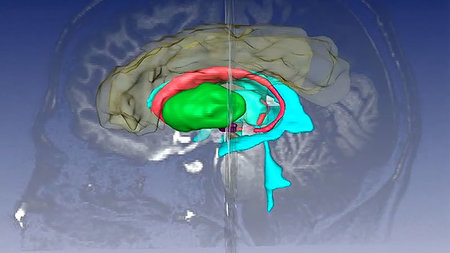Attention
Vision provides a rich collection of information about our environment. The difficulty in vision arises, since this information is not obvious in the image, it has to be actively constructed. Whereas earlier algorithms have favored a bottom-up approach, which converts the image into an internal representation of the world, more recent algorithms search for alternatives and develop frameworks which make use of top-down connections. Following the latter line of research, we have outlined that perception is an active process: planing stages in the frontal areas modify perception in early stages to construct the needed information from the environmental input. This research resulted in a novel approach termed ''population-based inference''. Predictions of the model are experimentally tested. A large-scale model has been demonstrated on natural scene perception.

Outline of the minimal set of interacting brain areas. Our model areas are restricted to elementary but typical processes and do not replicate all features in these areas. The arrows indicate known anatomical connections between the areas, which are relevant to the model. The area that sends feedforward input into the model is not explicitly modeled. The labels in the boxes denote the implemented areas. (b) Sketch of the simulated model areas. Each box represents a population of cells. The formation of those populations is a temporal dynamical process. Bottom-up (driving) connections are indicated by a yellow arrow and top-down (modulating) connections are shown as a red arrow. The two boxes in V4 and other areas indicate that we simulate two dimensions (e.g. ''color'' and ''form'') in parallel. The FEF pools across dimensions.
 |
 |
 |
|
Beuth, F, Wiltschut, J, Hamker, F. H. (2010) Attentive Stereoscopic Object Recognition. In: Machine Learning reports 04/2010, AG Computational Intelligence, University of Leipzig. p. 41-48. PDF-document |
Hamker, F. H. (2005) The emergence of attention by population-based inference and its role in distributed processing and cognitive control of vision. Journal for Computer Vision and Image Understanding. Special Issue on Attention and Performance in Computer Vision, 100:64-106. doi:10.1016/j.cviu.2004.09.005 |
|
Associated projects
German Research Foundation (DFG HA2630/4-1)
German Research Foundation (DFG HA2630/2-1)
Selected Publications
Novin, S., Fallah, A., Rashidi, S., Beuth, F., Hamker, F.H. (2021)
A neuro-computational model of visual attention with multiple attentional control sets
Vision Research, 189:104-118. doi:10.1016/j.visres.2021.08.009
Beuth, F., Hamker, F. H. (2015)
A mechanistic cortical microcircuit of attention for amplification, normalization and suppression
Vision Research, 116, 241-257. doi:10.1016/j.visres.2015.04.004
Antonelli, M., Gibaldi, A., Beuth, F., Duran, A. J., Canessa, A., Chessa, M., Solari, F., del Pobil, P., Hamker, F., Chinellato, E., Sabatini, S. P. (2014)
A hierarchical system for a distributed representation of the peripersonal space of a humanoid robot
IEEE Transactions on Autonomous Mental Development, doi:10.1109/TAMD.2014.2332875
Zirnsak, M., Beuth, F., Hamker, F. H. (2011)
Split of spatial attention as predicted by a systems-level model of visual attention
European Journal of Neuroscience. 33:2035-2045.
PDF-document
Zirnsak, M., Hamker, F. H. (2010)
Attention Alters Feature Space in Motion Processing.
Journal of Neuroscience. 30(20):6882-6890.
PDF-document
Zirnsak, M., Lappe, M., Hamker, F. H. (2010)
The spatial distribution of receptive field changes in a model of peri-saccadic perception: predictive remapping and shifts towards the saccade target.
Vision Research. 50:1328-1337.
PDF-document
Hamker, F. H., Zirnsak, M., Calow, D., Lappe, M. (2008)
The peri-saccadic perception of objects and space.
PLOS Computational Biology 4(2):e31
PDF-document
Hamker, F. H., Zirnsak, M. (2006)
V4 receptive field dynamics as predicted by a systems-level model of visual attention using feedback from the frontal eye field.
Neural Networks, 19:1371-1382
PDF-document
Hamker, F. H. (2005)
The emergence of attention by population-based inference and its role in distributed processing and cognitive control of vision.
Journal for Computer Vision and Image Understanding. Special Issue on Attention and Performance in Computer Vision, 100:64-106.
PDF-document
Hamker, F. H. (2005)
A computational model of visual stability and change detection during eye movements in real world scenes.
Visual Cognition, 12:1161-1176.
PDF-document
Hamker, F. H. (2005)
The Reentry Hypothesis: The Putative Interaction of the Frontal Eye Field, Ventrolateral Prefrontal Cortex, and Areas V4, IT for Attention and Eye Movement.
Cerebral Cortex, 15:431-447.
PDF-document
Hamker, F. H. (2005)
Chapter 98: How the detection of objects in natural scenes constrains attention in time.
In: L. Itti, J. Tsotsos & G. Rees (eds.) Neurobiology of Attention. Elsevier Science and Technology Books, pp. 600-604.
PDF-document
Hamker, F. H. (2004)
A dynamic model of how feature cues guide spatial attention.
Vision Research, 44:501-521.
PDF-document
Hamker, F. H. (2004)
Predictions of a model of spatial attention using sum- and max-pooling functions.
Neurocomputing, 56C:329-343.
PDF-document
Hamker, F. H. (2003)
The reentry hypothesis: linking eye movements to visual perception.
Journal of Vision, 11:808-816.
PDF-document





